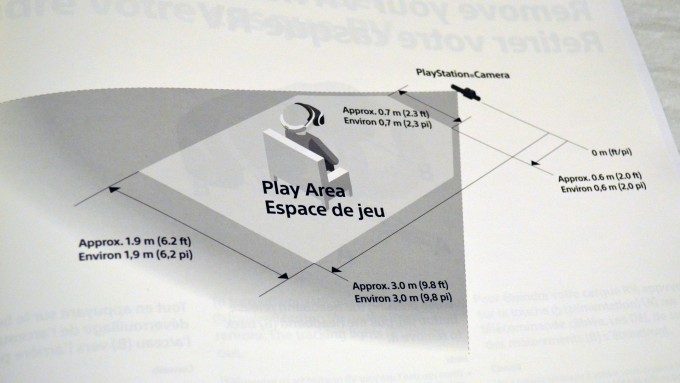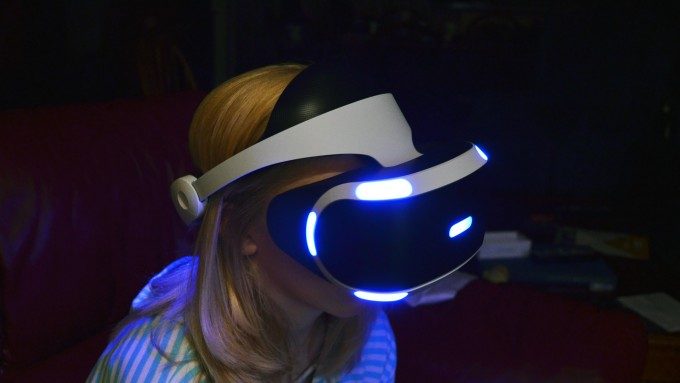Tracking
PlayStation VR’s tracking system uses the PlayStation Camera to track visible-light markers on the PSVR headset, PS4 controller, and PlayStation Move controllers. And while the system works well enough for a solid VR experience, it performs notably worse than the tracking we see on the Rift and Vive, and may be PSVR’s biggest downside in an otherwise impressive system.
Calibration & Alignment
You can (and should) calibrate the PSVR tracking system using software that’s built into the PS4. Through the PlayStation VR settings menu you can find the option which will ask you to hold the headset up to the camera and align it with an on-screen outline of the headset. This will be repeated for the front, sides, and back of the headset. The calibration process is similar for the PS4 controller and PlayStation Move controllers.
Camera alignment seems very important to achieving the best quality tracking the PSVR is capable of; unfortunately the system does a poor job of instructing the users how their camera and tracking space should be set up.
Instead of just telling you how far you should be seated from the camera, the instruction booklet tells you a bunch of seemingly arbitrary distances, like to distance from the camera to the front of the tracking volume, the width of the front of the tracking volume (which doesn’t match the width of the rear of the tracking volume) the distance to the rear of the tracking volume, and, quite confusingly, doesn’t show the ideal angle or altitude of the camera at all (the booklet diagram could almost be misconstrued as telling you to place the camera on the floor at your feet).
Optimizing the camera placement for seated vs. standing experiences was also not clear. Does one placement work best for both or should I move the camera? Only through experimentation did I find that mounted atop my TV seemed to be the best place, but even then it was tough to set the angle of the camera to work well for seated and standing experiences.
Sony would probably do well to be more instructive about helping users set up the ideal camera placement to achieve maximum tracking quality.
Tracking Quality
After getting a properly aligned camera and calibrating the system, the positional tracking quality of PSVR does not consistently hit that sub-millimeter accuracy mark that we’ve become accustomed to with high-end desktop VR headsets like the Rift and the Vive. On the other hand, the rotational tracking latency is spot on and feels every bit as good as the Rift and Vive.
Headset
The PlayStation VR headset itself, with 9 tracking lights, is the most accurately tracked object of the system, with the PS Move controllers coming in second, and the PS4 controller coming in at a distant third.
Face-on, the headset’s tracking is decent, but it has a visibly apparent jitter inside that will make you feel a little wobbly from time to time, especially for standing experiences. For the most part, the tracking quality is good enough that I wasn’t getting nauseas in the headset, which is good, but you should feel your balance sway a bit here and there, especially when there’s nearfield objects floating close by (as you can see them jitter in relation to your head, even when you are hardly moving).
Things get worse when you turn your head a significant amount, giving the camera less tracking lights to work with. I found that tracking jitter increased with fair consistency when turning my head, and when moving my head backward and forward perpendicular to the camera, the camera would often think I was moving closer to it by a few inches as I did so. More than anything else, I found this not-so-precise tracking more distracting than discomforting.
PlayStation Move
The PlayStation Move motion controllers suffer from a similar problem, and appear to have more tracking jitter than the headset (likely owed to their singular tracking light source). They still work well enough for intuitive motion gaming, but don’t have the same impressive accuracy that we’ve seen with the HTC Vive or Oculus Touch controllers. Fast movements especially (like swinging a sword or throwing things with much vigor) seem to be eschewed by most of the content we’ve seen so far, possibly due to limitations with the tracking.
Some PSVR experiences cause you to raise the Move controllers up in front of your head (like when aiming a gun), which can easily occlude the small number of markers on the headset, causing it to jitter more until you put your arms down.
DualShock Controller
 The PS4 controller seems to be the least accurately tracked of object of the bunch. As such, it tends not to be used in experiences which require accurate tracking.
The PS4 controller seems to be the least accurately tracked of object of the bunch. As such, it tends not to be used in experiences which require accurate tracking.
However at least one game I tried, Tumblr VR (which is a pretty cool game), can be played using the DualShock controller to balance blocks atop one another, but it’s jittery tracking can really detract from the experience. Thankfully the game supports the Move controllers which makes a huge difference.
While the tracking might not be what we’re used to from the world of high-end desktop VR, PSVR experiences that are designed with the limitations in mind have proven to be effective and extremely fun.
Drift
Drift is something that’s common among IMU-only tracked VR headsets (like Gear VR and Cardboard), but it’s been effectively eliminated on systems that use outside-in tracking (like the Rift and the Vive) because those systems have a static frame of reference against which the drift can be corrected.
Curiously, despite also using an outside-in tracking system, I’ve still seen a fair share of drift of Playstation VR. The good news is that Sony has made it easy to reset at any time by holding the Options button for a few seconds (however some apps seem to only treat that reset as a positional calibration and not a rotational recentering).
Why it drift happens in the first place on PSVR though is a bit of a mystery to me. I haven’t been able to put my finger on it just yet, but it seems to happen worse in some experiences than others; it could be a case of newer drift-correction code not yet being applied globally. Whatever the case, there’s hope that this could be improved through software with later updates.








